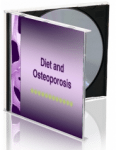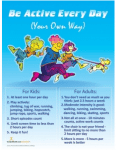May is Osteoporosis Awareness Month
 Salsa isn't the only thing on the agenda this month, because May is also Osteoporosis Awareness month. This week we will be discussing the ins and outs of bone health, especially as it relates to nutrition.Many of us think of bones like the steel in an office building -- a solid, unchanging framework. Actually, your 206 bones are more like a tree supporting a child's playhouse-- supportive, yet alive and needing proper conditions to stay healthy. Contrary to what most people think, bone health is more than just getting enough calcium. While calcium is critical, a variety of minerals, vitamins, and other components work together to make strong bones.
Salsa isn't the only thing on the agenda this month, because May is also Osteoporosis Awareness month. This week we will be discussing the ins and outs of bone health, especially as it relates to nutrition.Many of us think of bones like the steel in an office building -- a solid, unchanging framework. Actually, your 206 bones are more like a tree supporting a child's playhouse-- supportive, yet alive and needing proper conditions to stay healthy. Contrary to what most people think, bone health is more than just getting enough calcium. While calcium is critical, a variety of minerals, vitamins, and other components work together to make strong bones.
Got Calcium?
Calcium provides 65% of the weight of your bones. Since calcium is vital for nerve and muscle function, your body treats the skeleton like a calcium bank account. Approximately 600 to 700 mg of calcium moves in and out of your bones every day. If your diet is low in calcium, your body removes calcium from your bones, but does not replace it. If this occurs consistently over time, the calcium "bank" in your bones will be seriously depleted. Rich, heart-healthy sources of calcium include skim milk, nonfat yogurt, nonfat ricotta cheese, fortified soymilk, green leafy vegetables, fortified orange juice, and fortified whole grain products.
Got Boron?
This trace mineral helps keep calcium from being excreted in urine. The exact amount of boron needed for optimal bone health is not yet known, but a diet with plenty of fruits and vegetables should provide all the boron you need.
Got Magnesium?
While magnesium is used in over 300 enzymes, half of the body's magnesium is found in bones. If calcium supplies are low, magnesium can take the place of some calcium in bone. The suggested intake for magnesium is 350 mg per day (for men) or 280 mg (for women). Nuts and grains are excellent, heart-healthy food sources of magnesium, as are beans, dark green vegetables, fish, and seeds.
Got Vitamin D?
Vitamin D goes hand in hand with calcium and bone health. Unfortunately, it is a nutrient of concern, according to the Dietary Guidelines for Americans. That means that most people aren't getting enough vitamin D. This vitamin is unusual, in that it can be made from sunshine. The UV- B rays from sunshine penetrate the skin and convert a precursor into vitamin D. Twenty minutes of sun exposure per day provides most of the vitamin D you need -- without raising your skin cancer risk. Heart-healthy sources of vitamin D also include salmon, herring, sardines, skim milk, some yogurt, fortified soymilk, and fortified whole grain cereals.
Got Vitamin K?
Vitamin K is a fat-soluble vitamin that is found in dark green, leafy vegetables. The Nurses Health Study of over 72,000 women found that women who had the lowest intake of vitamin K had the highest number of hip fractures. Vitamin K is required in order to make bone proteins, and it can help keep calcium from being lost in the urine.
No Bones About It!
What is the bottom line for bone health? The best bone-building diet fits right into most guidelines for good nutrition, especially the Dietary Guidelines for Americans and MyPlate. Build your diet around whole grains, fruits, and vegetables, with a few servings of low-fat, calcium-rich foods. Make sure you get enough vitamin D, minimize your salt intake, and try to eat the right amount of protein for your weight. Exercise, especially walking and jogging, is very beneficial, too.By Carol Coughlin, RDThis post is brought to you by the Nutrition Education Store. Check out our wide range of educational posters, handouts, presentations, games, and more!

